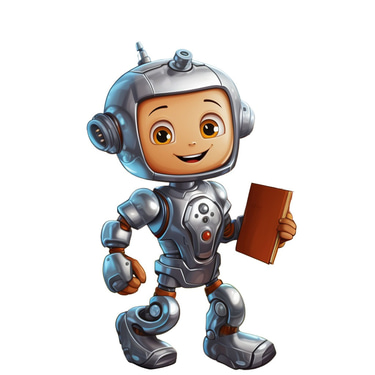🧠✨ AI Storyteller Project for Kids (Ages 8–14)
Creating an AI Storyteller is a fun and hands-on way for kids to spark creativity, explore the basics of artificial intelligence, and build storytelling skills. This step-by-step guide walks through how children can “train” an AI to help them invent imaginative stories using no-code and low-code platforms like Teachable Machine, Scratch, and Google Colab.
💡 Target Audience: Ages 8–14 (easily adaptable for younger or older learners)
🕒 Duration: 1–2 hours (or split across sessions)
🎯 Project Objective
Kids will provide creative prompts (e.g., “A time-traveling dinosaur”) and teach an AI to generate short stories based on those ideas. They’ll see how AI models learn from examples—just like people do!
🧰 Materials Needed
Computer or tablet with internet access
Kid-friendly platforms (choose based on skill level):
Teachable Machine – No-code, easy and visual
Scratch – Low-code, drag-and-drop coding
Google Colab – Python-based (for older kids, with adult support)
Paper, pencils, or whiteboard for brainstorming
(Optional) Canva, Paint, or drawing app to illustrate stories
🪜 Step-by-Step Instructions
✅ Step 1: Kickoff & Inspiration (10 minutes)
Introduce the Mission: “Today, you're going to teach an AI how to tell stories—just like training a puppy to do tricks, but cooler!”
Simple AI Analogy: “Think of AI as a robot brain that learns by example. It doesn’t think like us—it matches patterns from what you teach it.”
Group Brainstorm: “What kind of stories do you love?” List ideas like:
Space adventures 🌌
Magical animals 🐉
Talking objects 🎩
🧠 Tip: Show a fun AI-generated story as an example (use ChatGPT or generate in advance).
✍️ Step 2: Write Creative Prompts (15 minutes)
Activity: In pairs or solo, kids write 5–10 short story prompts (1–2 sentences each).
Examples:
“A robot gets stuck in a time loop.”
“A penguin becomes mayor of a beach town.”
Next Step: For each prompt, create a mini-story (2–3 sentences).
Example:
Prompt: “A unicorn who forgets how to fly.”
Story: “Luna the unicorn crashed into a bush, but her forest friends helped her remember the secret flying song.”
💡 Encourage silly, wild, or magical ideas—there are no wrong answers!
💻 Step 3: Choose the Right Platform (5 minutes)
PlatformBest ForDescriptionTeachable MachineAges 8+, beginnersNo-code platform by Google. Easy to train a text-based “classifier” AI.ScratchAges 9–12Block-based coding to make a simulated AI storyteller using logic & lists.Google ColabAges 12+Python-based environment to use or fine-tune real language models (e.g., GPT-2). Adult supervision required.
✅ Recommendation: Start with Teachable Machine or Scratch for fun and ease. Use Colab if kids are already learning Python or want more challenge.
🧠 Step 4: Train the AI (20–30 minutes)
🟩 Option 1: Teachable Machine (No-Code)
Go to Teachable Machine – Text.
Create “classes” for story types (e.g., Adventure, Funny, Magic).
Add prompts and stories for each class.
Example:
Class: “Funny”
Input: “A llama goes to school.”
Output: “The llama wore glasses and got straight As in recess!”
Train the model and test new prompts to see how the AI classifies or responds.
Expand the story based on the AI's suggestion.
🟦 Option 2: Scratch (Low-Code)
Visit scratch.mit.edu.
Create a sprite (e.g., robot or wizard).
Use Lists to store prompts and story responses.
Program the sprite to:
Ask for a prompt
Respond with a matching story using "if-then" blocks
Add sound effects, backdrops, or interactive elements.
🟥 Option 3: Google Colab (Code-Based)
Use a prebuilt Colab notebook (e.g., GPT-2 or GPT-Neo with Hugging Face).
Kids input their story prompts and mini-stories.
Fine-tune or use prompt completion features to generate new stories.
Requires setup, adult help, and basic Python knowledge.
🧠 Tip: Let kids demo the tool to each other—peer teaching deepens learning!
🧪 Step 5: Test the AI (15 minutes)
Try fun prompts NOT used in training:
“A pancake becomes president.”
“A hamster opens a detective agency.”
Discuss:
“Was the story funny? Surprising?”
“Did the AI give you a good idea?”
Add more examples if the AI struggles—learning from mistakes is part of the fun!
🎮 Make it a challenge: Kids vote for the silliest, most magical, or scariest story.
🗣️ Step 6: Share & Reflect (10–15 minutes)
Present favorite AI-generated or human-expanded stories.
Discuss:
“What did you like about teaching the AI?”
“Did it learn what you expected?”
Explain: AI doesn’t “think”—it learns from patterns in the examples you gave.
Draw scenes from stories or build mini-books.
🎨 Build a "Digital Story Wall" or gallery with prompts + drawings!
➕ Step 7: Optional Extensions
Add More Data: Make the AI smarter with new story examples.
Build a Game: In Scratch, kids code an interactive story challenge.
Compare Models: Let older kids try GPT (via ChatGPT) and compare outputs.
Illustrate the Story: Use Canva or coloring apps to turn stories into comics.
🛡️ Safety & Ethics
Keep Prompts Kid-Friendly: No violence or scary content (unless it’s silly-spooky).
No Personal Info: Never enter names, addresses, or personal stories.
AI Isn’t Human: Remind kids that AI doesn’t understand—it mimics patterns.
🧵 Sample Workflow (Teachable Machine)
Prompt: “A robot lost in a jungle.”
Story: “It met a parrot who gave it directions to a hidden battery.”
Add to “Adventure” class.
Train model.
New prompt: “A robot on the moon” → AI says “Adventure” → New story: “It followed alien footprints into a glowing crater.”
📚 Resources
Sample GPT-2 Colab Notebook
Creative Prompt Ideas
The Amazing Story Generator (book)
